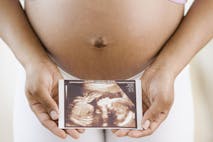
South Dakota sues Mayday Health over gas station abortion ads
Bridget Sielicki
·
Researchers: Mom’s brain is ‘sculpted’ during pregnancy, revealing ‘underlying beauty’
An amazing new study from the journal Nature shows the profound effects of pregnancy on a woman’s brain – some of which last years after birth – are even more extensive than previously thought.
In the study, neuroscientist, co-author of the study, and first-time mom Liz Chrastil scanned her brain 26 times – before, during, and after her pregnancy with her son. What the authors found when mapping and analyzing the data was a detailed picture of the changes of the brain, inside and out, throughout pregnancy and into the postpartum period.
“It’s the first detailed map of the human brain across gestation,” said senior author Emily Jacobs from the University of California, Santa Barbara, according to the BBC. “We’ve never witnessed the brain in a process of metamorphosis like this. We are finally able to observe changes to the brain in real time.”
But what are these changes for? Chrastil distilled a portion of the study in a tweet: “Brain changes during pregnancy are likely an evolutionarily-tuned suite of adaptations to help maternal behavior and bonding. We hope to find out more about mechanisms and what it means for things like postpartum depression in the coming years.”
“There is so much about the neurobiology of pregnancy that we don’t understand yet, and it’s not because women are too complicated. It’s not because pregnancy is some Gordian knot,” Jacobs said according to the AP. “It’s a byproduct of the fact that biomedical sciences have historically ignored women’s health.”

The brain consists of both gray matter and white matter. Gray matter is the wrinkly exterior part of the brain that’s responsible for things like thinking, learning, memory, and emotions. White matter is the interior part of the brain that helps process information, helps focus, plays a role in balance and in sending and receiving nerve signals. The study found that most (80%) of the regions they looked at had reductions in the gray matter of the brain – up to 4% on average – similar to changes that take place in the brain during puberty. They also found that white matter was able to transmit signals throughout the brain more efficiently.
Article continues below
Dear Reader,
In 2026, Live Action is heading straight where the battle is fiercest: college campuses.
We have a bold initiative to establish 100 Live Action campus chapters within the next year, and your partnership will make it a success!
Your support today will help train and equip young leaders, bring Live Action’s educational content into academic environments, host on-campus events and debates, and empower students to challenge the pro-abortion status quo with truth and compassion.
Invest in pro-life grassroots outreach and cultural formation with your DOUBLED year-end gift!
Interestingly, while the scans showed that white matter returned to its original condition on childbirth, the gray matter changes lasted around two years postpartum. Although a reduction in brain matter sounds alarming, Jacobs said it’s actually nothing to worry about, as it allows the brain to become more streamlined and specialized to the task of becoming a parent.
Jacobs likened these changes to the carving of Michaelangelo’s David. “The artist starts off with this big block of marble and the underlying beauty is revealed through the art of removal, carefully honing and fine-tuning the material,” she said, according to the New York Times. She added that in the study, “you can see the sculpting of the brain unfold week by week.”
Other neuroscientists around the world have already benefited from the research Chrastil and Jacobs have done, whose efforts have become the springboard for the international Maternal Brain Project to gather similar scans.
Of note, Elseline Hoekzema of Amsterdam University Medical Center, who heads the Pregnancy and the Brain Lab, has done other brain scans on pregnant women. She told the New York Times that the changes were such that they could tell who was pregnant simply by their brain scans.
Hoekzema said that the research “suggests that brain changes during pregnancy relate to the way a mother’s brain and body react to infants” and that changes correlated with “maternal-fetal bonding, nesting behavior and the way a woman’s heart rate reacts to seeing an infant.”
Live Action News is pro-life news and commentary from a pro-life perspective.
Contact editor@liveaction.org for questions, corrections, or if you are seeking permission to reprint any Live Action News content.
Guest Articles: To submit a guest article to Live Action News, email editor@liveaction.org with an attached Word document of 800-1000 words. Please also attach any photos relevant to your submission if applicable. If your submission is accepted for publication, you will be notified within three weeks. Guest articles are not compensated (see our Open License Agreement). Thank you for your interest in Live Action News!

Bridget Sielicki
·
Analysis
Cassy Cooke
·
Analysis
Cassy Cooke
·
Analysis
Cassy Cooke
·
Analysis
Cassy Cooke
·
Analysis
Nancy Flanders
·
Human Interest
Laura Nicole
·
Human Interest
Laura Nicole
·
Newsbreak
Laura Nicole
·
Human Interest
Laura Nicole
·
Human Interest
Laura Nicole
·